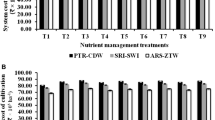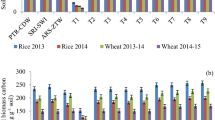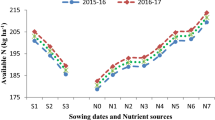Abstract
The resource-intensive agriculture involving use of chemical fertilizers, irrigation, and tillage practices is a major cause of soil, water, and air pollution. This study was conducted to determine whether integrated use of nutrient, water, and tillage (reduced) can be manipulated to improve the population of plant growth promoting rhizobacteria (Azotobacter, Bacillus, and Pseudomonas) to enhance soil fertility and yield. The study was conducted in the Indo-Gangetic plain (IGP) region of India, where resource-intensive agriculture is practiced. Various combinations of chemical (urea) and organic fertilizers (farmyard manure (FYM), biofertilizer, and green manure) were used on replicated field plots for all the experiments. The effect of integrated resource management (IRM) on activities of Azotobacter, Bacillus, and Pseudomonas and its relation to the yields of rice and wheat crops in subtropical soils of IGP region were also observed. The increased population of all the three microbes, namely, Azotobacter (5.01–7.74 %), Bacillus (3.37–6.79 %), and Pseudomonas (5.21–7.09 %), was observed due to improved structure and increased organic matter in the soil. Similarly, kernel number and 1000 kernel weight were found increased with sole organic N source, three irrigations, and conservation tillage. Thus, it was found that the IRM practices affect the environment positively by increasing the population of beneficial soil microbes and crop yield as compared to high-input agriculture (conventional practices).



Similar content being viewed by others
References
Albiach, R., Canet, R., Pomares, F., & Ingelmo, F. (2000). Microbial biomass content and enzymatic activities after the application of organic amendments to a horticultural soil. Bioresource Technology, 75, 43–48.
Daughtry, C. S., Serbin, G., Reeves, J. B., III, Doraiswamy, P. C., & Hunt, R., Jr. (2010). Spectral reflectance of wheat residue during decomposition and remotely sensed estimates of residue cover. Remote Sensing, 2, 416–431.
Davis, S. C., Parton, W. J., Dohleman, F. G., & Smith, C. M. (2010). Comparative biogeochemical cycles of bioenergy crops reveal Nitrogen-fixation and low greenhouse gas emission in a Miscanthus x giganteus agro-ecosystems. Ecosystem, 13, 144–156.
Gaind, S., & Nain, L. (2010). Exploration of composted cereal waste and poultry manure for soil restoration. Bioresource Technology, 101(21), 8492.
Ghosh, P. K., Das, A., Saha, R., Kharkrang, E., Tripathi, A. K., Munda, G., & Ngachan, S. V. (2010). Conservation agriculture towards achieving food security in north-east India. Current Science, 99(7), 915–21.
Gomez, K. A., & Gomez, A. A. (1985). Statistical procedures for agricultural research. New York: John Wiley and Sons.
Green, V. S., Stott, D. E., & Diack, M. (2006). Assay for fluorescein diacetate hydrolytic activity: optimization for soil samples. Soil Biology & Biochemistry, 38, 693–701.
Gunapala, N., & Scow, K. M. (1998). Dynamics of soil microbial biomass and activity in conventional and organic farming systems. Soil Biology & Biochemistry, 30, 805–816.
Hayat, R., Ali, S., Amara, U., Khalid, R., & Ahmed, I. (2010). Soil beneficial bacteria and their role in growth promotion: a review. Annual Review of Microbiology. doi:10.1007/S13213-010-0117.1.
Iker, M., Isabel, A., & Carlos, G. (2010). Beneficial effects of organic fertilization and no-tillage on fine-textured soil properties under two different forage crop rotations. Soil Science, 175(4), 175–185.
Jackson, M.T. (2009). Revitalizing the rice-wheat cropping systems of indo-gangetic plains: Adaptation and adoption of resource conserving technologies in India, Bangladesh, and Nepal. Final Report, USAID, (IRRI Ref. No.: DPPC2007 100), p.17.
Jensen, H. L. (1954). The Azotobacteriaceae. Bacteriological Reviews, 18, 195–213.
King, J. (2010). Harmful effects of nitrogen containing fertilizers on aquatic ecosystem. http://www.ehow.com/list_6163446.
King, E. O., Ward, M. K., & Raney, D. E. (1954). Two simple media for the demonstration of pyocyanin and fluorescine. Journal of Laboratory and Clinical Medicine, 44, 301.
Kumar, S., Shivani, Kumar, U., & Manibhushan. (2014). Productivity and Economics of Rice-Wheat Cropping System as Affected by Methods of Sowing and Tillage Practices in the Eastern Plains. Journal of AgriSearch, 1(3), 145–150.
Lamm, F. R., Aiken, R. M., & Abou Kheira, A. A. (2009). Corn yield and water use characteristics as affected by tillage, plant density, and irrigation. Transactions of ASABE, 52(1), 133–143.
Liu, X., Liu, J., Xing, B., Herbert, S. J., Meng, K., Xiaozeng, H., & Zhang, X. (2005). Effect of long term continuous cropping, tillage and fertilization on soil organic carbon and nitrogen of black soils in China. Communications in Soil Science and plant Analysis, 36, 1229–1239.
Liu, C., Wang, K., Meng, S., Zhang, X., Zhou, Z., Han, S., Chen, D., & Yang, Z. (2011). Effects of irrigation, fertilization and crop straw management on nitrous oxide and nitric oxide emissions from a wheat-maize rotation field in northern-China. Agriculture Ecosystem and Environment, 140(1–2), 226–233.
Mahajan, A., & Gupta, R. D. (2009). Integrated Nutrient Management (INM) in a sustainable rice-wheat cropping system. U.S.A.: Springer publications. doi:10.1007/978-1-4020-9875-8.
Marx, J. (2004). The roots of plant–microbe collaborations. Science, 304, 234–236.
Nain, L., Rana, A., Joshi, M., Jadhav, S. D., Kumar, D., Shivay, Y. S., Paul, S., & Prasanna, R. (2010). Evaluation of synergistic effects of bacterial and cyanobacterial strains as biofertilizers for wheat. Plant and Soil, 331(1–2), 217–30.
Pikovskaya, R. I. (1948). Mobilization of phosphorous in soil in connection with vital activity of some microbial species. Microbiology, 17, 362–70.
R.W.C. (Rice-Wheat Consortium) (2005). Rice-wheat cropping systems of indo-gangetic plains, New Delhi, India. Research highlights 2004.
Rousk, J., & Bååth, E. (2007). Fungal and bacterial growth in soil with plant materials of different C/N ratios. FEMS Microbiology Ecology, 62, 258–267.
Saha, S., Chakraborty, D., Sharma, A. R., Tomar, R. K., Bhadrary, S., Sen, U., Behera, U. K., Purakayastha, T. J., Garg, R. N., & Kalra, N. (2010). Effect of tillage and residue management on soil physical properties and crop productivity in maize (Zea mays)–Indian mustard (Brassica juncea) system. Indian Journal of Agricultural Science, 80(8), 679–685.
Sharma, M. P., Bali, S. V., & Gupta, D. K. (2001). Soil fertility and productivity of rice (Oryza sativa)-wheat (Triticum aestivum) cropping system in an Inceptisol as influenced by integrated nutrient management. Indian Journal of Agricultural Science, 71(2), 82–86.
Singh, G., & Kumar, D. (2008). Influence of tillage, water regimes and integrated nitrogen management practices on soil quality indices in rice (Oryza sativa L.) in the Indo-Gangetic plains. Archives of Agronomy and Soil Science, 00, 1–12.
Singh, Y., Singh, B., Meelu, O. P., & Khind, C. S. (2000). Long term effects of organic manuring and crop residues on the productivity and sustainability of rice-wheat cropping system of North- West India’. In: I. P. Abrol, K. F. Bronson, J. M. Duxbury, R. K. Gupta (Eds.), Long-Term Soil Fertility Experiments in Rice-Wheat Cropping Systems. RWC Paper series 6 (pp. 149–162) .New Delhi.
Singh, G., Marwaha, T. S., & Kumar, D. (2009). Effect of resource conserving techniques on soil microbial parameters in rice crop in indo-gangetic plains under maize-wheat crop rotation. Indian Journal of Agricultural Science, 79(2).
Smith, J. L., Papendick, R. I., Bezdicek, D. F., & Lynch, J. M. (1993). Soil microbial ecology. In B. F. Metting (Ed.), Soil organic matter dynamics and crop residue management (pp. 65–95). New York: Marcel Dekker Inc.
Taylor, J. P., Wilson, B., & Mills, M. S. (2002). Comparison of microbial numbers and enzymatic activities in surface soils and subsoils using various techniques. Soil Biology & Biochemistry, 34, 387–401.
Verma, J. P., Yadav, J., Tiwari, K. N., Lavakush, & Singh, V. (2010). Impact of plant growth promoting rhizobacteria on crop production. International Journal of Agricultural Research, 5(11), 954–83.
Yang, J., & Zhang, J. (2010). Crop management techniques to enhance harvest index in rice. Journal of Experimental Botany. doi:10.1093/jxb/erg112.
Zhang, F.S., Fan M.S., & Zhang, W.F. (2007). Principles, dissemination, and performance of Fertilizer Best Management Practices developed in China. Fertilizer Best Management Practices, First edition, International Fertilizer Industry Association (IFA), Paris, France, August 2007, ISNB 2-9523139-2-X. pp. 135-146.
Zorita, M. D., & Canigia, M. V. F. (2008). Field performance of a liquid formulation of Azospirillium brasilense on dryland wheat productivity. European Journal of Soil Biology, 45(1), 3–11.
Author information
Authors and Affiliations
Corresponding author
Rights and permissions
About this article
Cite this article
Sharma, P., Singh, G., Sarkar, S.K. et al. Improving soil microbiology under rice-wheat crop rotation in Indo-Gangetic Plains by optimized resource management. Environ Monit Assess 187, 150 (2015). https://doi.org/10.1007/s10661-015-4338-4
Received:
Accepted:
Published:
DOI: https://doi.org/10.1007/s10661-015-4338-4




